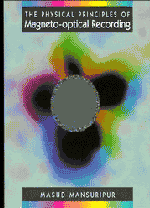Book contents
- Frontmatter
- Contents
- Preface
- 1 Overview of Optical Data Storage
- 2 Optics of Gaussian Beams
- 3 Theory of Diffraction
- 4 Diffraction of Gaussian Beams from Sharp Edges
- 5 Optics of Thin Films and Multilayers
- 6 Magneto-optical Readout
- 7 Effects of High-numerical-aperture Focusing on the State of Polarization
- 8 Computer Modeling of the Optical Path
- 9 Noise in Magneto-optical Readout
- 10 Modulation Coding and Error Correction
- 11 Thermal Aspects of Magneto-optical Recording
- 12 Fundamentals of Magnetism and Magnetic Materials
- 13 Magnetostatics of Thin-film Magneto-optical Media
- 14 Mean-field Analysis of Amorphous Rare Earth–Transition Metal Alloys
- 15 Magnetization Dynamics
- 16 Origins of Coercivity
- 17 The Process of Thermomagnetic Recording
- 18 Media Characterization
- References
- Index
4 - Diffraction of Gaussian Beams from Sharp Edges
Published online by Cambridge University Press: 07 September 2010
- Frontmatter
- Contents
- Preface
- 1 Overview of Optical Data Storage
- 2 Optics of Gaussian Beams
- 3 Theory of Diffraction
- 4 Diffraction of Gaussian Beams from Sharp Edges
- 5 Optics of Thin Films and Multilayers
- 6 Magneto-optical Readout
- 7 Effects of High-numerical-aperture Focusing on the State of Polarization
- 8 Computer Modeling of the Optical Path
- 9 Noise in Magneto-optical Readout
- 10 Modulation Coding and Error Correction
- 11 Thermal Aspects of Magneto-optical Recording
- 12 Fundamentals of Magnetism and Magnetic Materials
- 13 Magnetostatics of Thin-film Magneto-optical Media
- 14 Mean-field Analysis of Amorphous Rare Earth–Transition Metal Alloys
- 15 Magnetization Dynamics
- 16 Origins of Coercivity
- 17 The Process of Thermomagnetic Recording
- 18 Media Characterization
- References
- Index
Summary
Introduction
In this chapter, as a first application of the mathematical results derived in Chapter 3, we describe the far-field pattern obtained when a Gaussian beam is reflected from (or transmitted through) a surface with a sharp discontinuity in its reflection (or transmission) function. A good example of situations in which such phenomena occur is the knife-edge method of focus-error detection in optical disk systems; here a knife-edge partially blocks the column of light, allowing a split detector in the far field to sense the sign of the beam's curvature. Another example is the diffraction of the focused spot from the sharp edge of a groove. The far-field pattern in this case is used to derive the track-error signal, which drives the actuator responsible for track-following. Readback of the embossed pattern of information on the disk surface (e.g., data marks on CD and CD-ROM, Preformat marks on WORM and magneto-optical media) also involves diffraction from the edges of small bumps and/or pits.
This chapter begins with a general description of the problem and a derivation of all relevant formulas in section 4.1. In subsequent sections several specific cases of the general problem are treated; the emphasis will be on those instances where diffraction from a sharp edge finds application in optical-disk data storage systems.
- Type
- Chapter
- Information
- The Physical Principles of Magneto-optical Recording , pp. 107 - 127Publisher: Cambridge University PressPrint publication year: 1995



